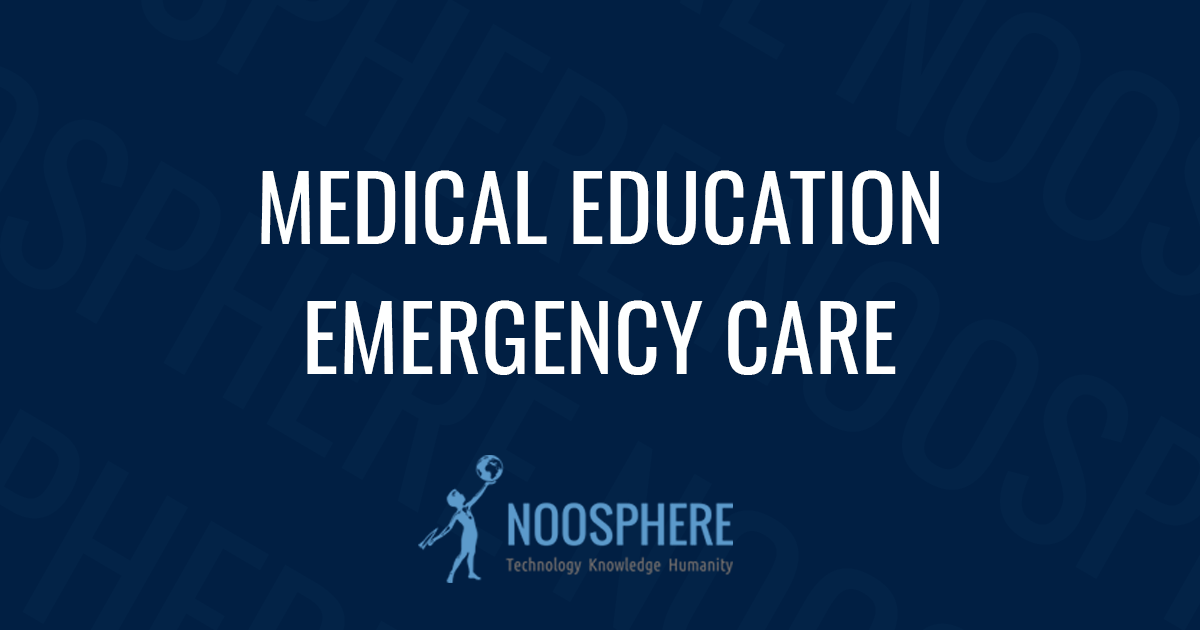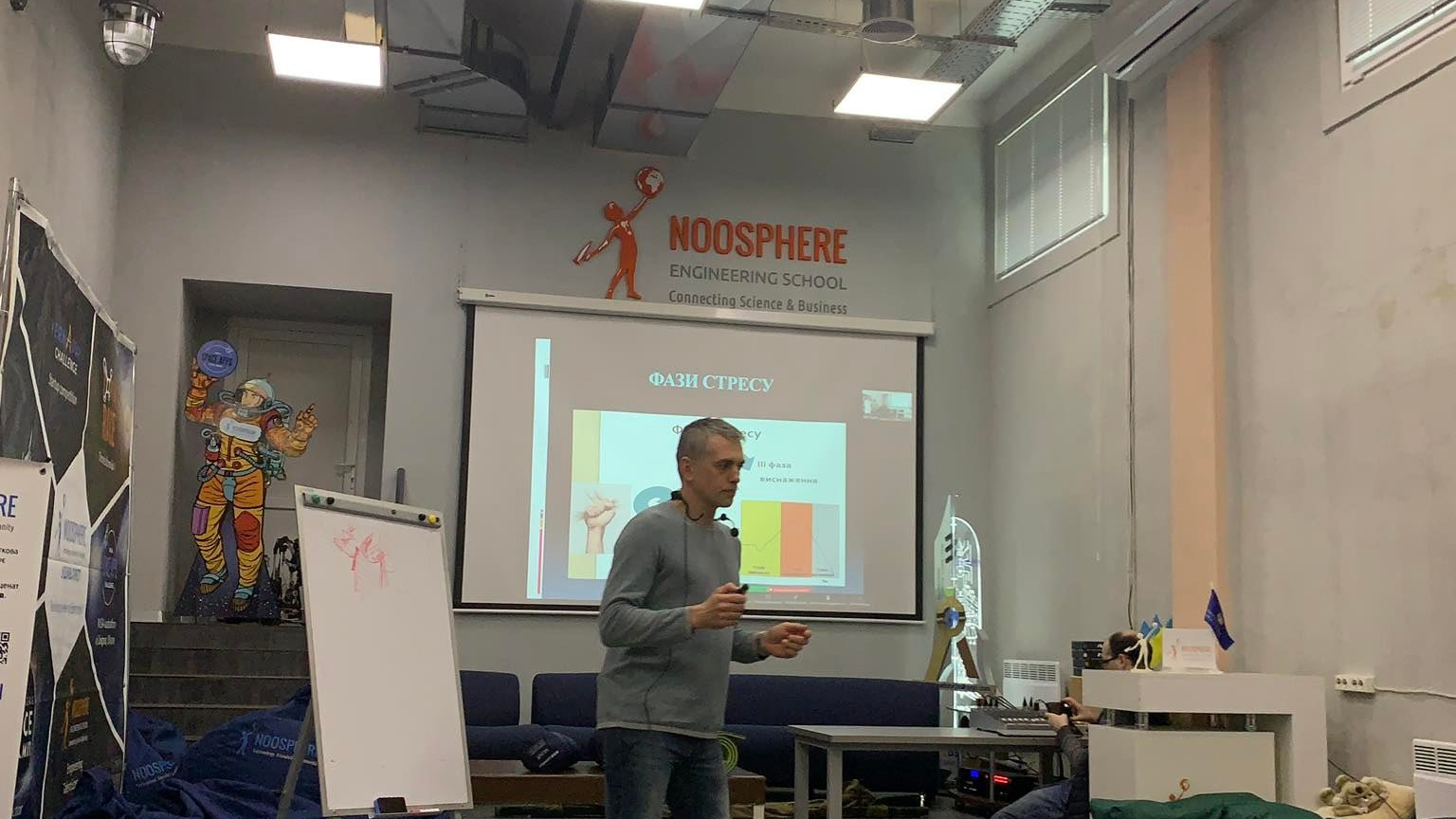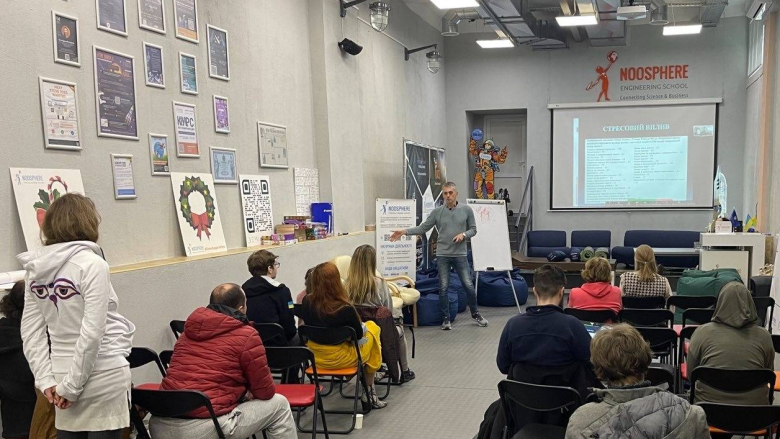When the war started, Noosphere was forced to abandon our usual STEM events. But we continued to educate. Hackathons, conferences and startup competitions have been replaced by current topics of relevance.
In March and April, we held a series of online and in-person lectures on medical education.
The first lesson was devoted to emergency protocols, the second – to treating burns, frostbite and prolonged compression. The third curse was dedicated to overcoming post-traumatic syndrome.
Lectures were given by Oleksiy Vinnyk, Candidate of Medical Sciences and Associate Professor of the Department of General Medicine. Also, Oleksiy Vinnyk completed courses on physical therapy at Oles Honchar Dnipro National University.
In total, 352 registrations were received for the lectures online and offline.
Here, you can find a summary of the highlights of the lecture series.

There are basic algorithms and rules for providing emergency care. How to determine who needs help first, if more than one person is affected?
There are 3 victim states:
- Urgent condition – assistance must be provided within 60 minutes at the most
- Delayed condition – help must be provided no later than 120 minutes
- Minimal damage
A simple system will help you identify these conditions:
- Can a person walk?
Yes – minimal damage, so the person can be evacuated from the scene
- Can a person breathe?
If not, the airways should be inspected and cleared if necessary. Without breathing a person dies in 2 minutes.
Then protocols will help us – special algorithms for rescue operations, encrypted with abbreviations that are easy to remember in emergencies. By following the protocol, you can provide first aid to the victim efficiently and accurately.
In the lecture, we learned the protocols MARCH, SETTUP, AVPU and NEXUS.
MARCH – the sequence of actions when we first identified the victim.
It contains the main consecutive points of assistance, including:
- Massive hemorrhage, It is essential to stop life-threatening bleeding because a person dies very quickly from massive bleeding. It is necessary to apply a tourniquet or apply direct pressure to the wound, followed by tight tamponade of the wound.
- Airway (Respiratory tract) – ensuring airway patency. Check how passable the victim’s airway is, and whether there is access to air.
- Respiration – closing all open chest wounds. Check if the person has the ability to breathe. This applies to chest and lung damage.
- Circulation (blood) – complete examination of wounds, stopping bleeding, diagnosis of shock.
- Hypothermia – preventing hypothermia. You need to wrap the victim in a blanket or anything that will help insulate them from the cold floor.
Why use this sequence? These are the most dangerous injuries, prioritized.
The next protocol we’ll talk about is SETTUP. It is spelled incorrectly on purpose because mistakes are better remembered.
So what do these letters mean?
- Stop – when you find yourself in trauma, the first thing you do is STOP. You need to stop yourself and others so that no one interferes with helping.
- Evaluate – evaluate your surroundings and determine any dangers.
- Traffic – determine what is moving around you: people, cars.
- Tape – trauma scene needs to be fenced. Anything: ribbon, tape, bags. As an example, the first rule of motorcyclists – in an accident, other motorcyclists come to the rescue and block the road with their motorcycles.
- Unpredictable – Always remember that anything can happen at any time.
- Protective gear – don’t forget about your safety. If possible, use gloves and other personal protective equipment.
Why use this protocol? When a person assists in an emergency, their own safety is most important. You need to take care of your own safety so that you are able to help others.
If you are directing a large disaster site with multiple victims, the AVPU protocol details the priority of providing assistance to victims.
According to the AVPU protocol, we define 4 priority categories.
- Alert – first, assess whether someone is conscious.
- Voice – you need to give a voice signal. “Hey!”, “Is anyone alive?”. People with a clear head are usually the least in need of immediate help. These are the people who can respond to you. Some of the wounded will not be aware of what is happening, but if they respond in any way, it is a positive sign.
- Pain – If a person cannot call back, it is necessary to assess whether they can respond to pain. The trapezius muscle (often referred to as the trapezius muscle) is one of the largest superficial muscles located on the back of the neck. It’s quite painful, but safe to test.
- Unresponsive – you need to evaluate those who do not react to your actions. Those who can signal still have the strength.
We provide assistance first to those victims who are unresponsive because we cannot accurately assess their condition. They are potentially the most severely injured. Then we help those who respond to pain but do not respond vocally. And then we help everyone else.
Why in this order? If a person is in contact and can communicate and follow simple instructions, it means they can breathe and feel relatively normal. In addition, these people can explain that they are in pain.
The latest protocol is NEXUS. A neck injury should always be suspected because the neck is the most mobile part of the spine. The neck also connects the brain to the rest of the body. Most neck injuries require treatment.
Neck injury is suspected in 4 scenarios:
- When falling from a height
- After diving headfirst into water
- As a result of an accident
- When intoxicated
The NEXUS protocol helps to assess neck injuries:
- Neurological (neurological manifestations) – when a person cannot raise his hand, move his legs, fingers, etc.
- Ethanol (alcohol) – fumes, alcohol poisoning.
- eXtreme (extreme) – high- or low-energy trauma. Low energy usually arises from falling from a height at or below their own height. All other injuries are related to high energy.
- Unresponsible – we considered this in the AVPU protocol. If a person does not respond and does not respond to pain and touch.
- Softness – swelling or instability of the neck. The neck is always examined by one person. This should be done as carefully as possible. No need to make sudden movements.
What if we suspect a neck injury? You need to apply a brace and stabilize for movement. Ideally, use a collar, but if not – you will have to improvise. You can make a brace from sweaters, pants, etc.
It is also important to remember the general rules of emergency that apply to all protocols. Massive bleeding should be stopped 2-3 minutes after detection. Airway obstruction – up to 4-5 minutes. Chest injuries – from 40 to 50 minutes.

To consolidate and supplement the material, as well as to see illustrative examples, we recommend watching the video on helping bleeding and how to examine a person who lost consciousness on the street.
The next lecture, the notes of which we recommend you to read, was devoted to emergency help with burns, frostbite and chronic compression syndrome — a very serious problem that affects people who are trapped.

The last lecture was devoted to post-traumatic syndrome. We also suggest reading the main tips on how to overcome the syndrome that occurs not only in people who were directly injured, but also in witnesses of the disaster, or even those who watch the psychologically difficult news.
Constantly repeat these basic rules and protocols of action in emergencies, and share them with others. Take care of yourself and your loved ones!
